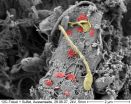(Press-News.org) University of Texas Medical Branch at Galveston researchers have discovered that the commonly used antidepressant drug paroxetine could also become a therapy for the vascular complications of diabetes.
The scientists made their discovery after screening 6,766 clinically used drugs and pharmacologically active substances.
"We developed this assay and used it to test literally every single existing drug and a good selection of other biologically active compounds," said UTMB professor Csaba Szabo, senior author of a paper on the research published online by Diabetes. "We were quite surprised when paroxetine came out as an active compound —a result, we later determined, of what seems to be a completely new effect unrelated to its antidepressant actions and not shared by any other known antidepressant drug."
The initial screening process tested the ability of different compounds to protect the cells that make up the inner linings of blood vessels from the destructive effects of the high sugar levels produced by diabetes, known as hyperglycemia. In people with diabetes, hyperglycemia causes these endothelial cells to generate toxic molecules known as reactive oxygen species (ROS), which ravage blood-vessel linings and lead to diabetic endothelial dysfunction, the key factor in such destructive diabetic complications as heart attacks, strokes, retinopathy, nephropathy and neuropathy.
In subsequent test-tube studies, researchers found that paroxetine — which is sold as an antidepressant under the trade name "Paxil" — prevents hyperglycemia-initiated ROS damage to endothelial cells in two ways. First, it directly reduces concentrations of superoxide, a powerful ROS. Second, it suppresses superoxide production by mitochondria, tiny structures whose real job is making the energy-transfer molecules needed for most cellular processes. In a hyperglycemic environment, mitochondria are cells' biggest source of superoxide. According to the researchers' findings, paroxetine inhibits this activity without interfering with the mitochondria's vital normal function.
Further experiments yielded still more evidence that paroxetine protects endothelial cells under hyperglycemic conditions. Reactive oxygen species cause significant damage to DNA, RNA and proteins, but cell-culture experiments showed that paroxetine significantly reduced this effect. The drug had similarly beneficial results when tested on rat "aortic rings" — small pieces of blood vessel kept alive with tissue-culture techniques. When treated with the vasodilator acetylcholine, these rings dilated just as if they were still part of a functioning circulatory system; endothelial dysfunction caused by diabetic hyperglycemia normally interferes with this function, but paroxetine restored it.
Finally, the researchers tested paroxetine in rats that had been injected with streptozotocin, a chemical that induces diabetes. The animals given paroxetine developed hypoglycemia, but like the aortic rings, their arteries retained the ability to dilate — an indication that the drug had prevented damage to their epitheliums.
"The future potential of this study is that we may be able to 're-purpose' paroxetine for the experimental therapy of diabetic cardiac complications," Szabo said. "We'll need to carefully characterize its safety profile in diabetic patients, but I think there's definite potential here."
###
Other authors of the Diabetes paper include instructor Dr. Domokos Gerö, research fellow Petra Szoleczy, postdoctoral fellow Kunihiro Suzuki, postdoctoral fellow Katalin Módis, faculty associate Dr. Gabor Oláh and postdoctoral fellow Ciro Colletta. This research was supported by the Juvenile Diabetes Foundation, the American Heart Association and the James W. McLaughlin Endowment.
Study shows antidepressant could do double duty as diabetes drug
2012-12-14
ELSE PRESS RELEASES FROM THIS DATE:
Nanocrystals not small enough to avoid defects
2012-12-14
Nanocrystals as protective coatings for advanced gas turbine and jet engines are receiving a lot of attention for their many advantageous mechanical properties, including their resistance to stress. However, contrary to computer simulations, the tiny size of nanocrystals apparently does not safeguard them from defects.
In a study by researchers with the U.S. Department of Energy (DOE)'s Lawrence Berkeley National Laboratory (Berkeley Lab)and collaborators from multiple institutions, nanocrystals of nickel subjected to high pressure continued to suffer dislocation-mediated ...
Hard-to-treat Myc-driven cancers may be susceptible to drug already used in clinic
2012-12-14
PHILADELPHIA — Drugs that are used in the clinic to treat some forms of breast and kidney cancer and that work by inhibiting the signaling molecule mTORC1 might have utility in treating some of the more than 15 percent of human cancers driven by alterations in the Myc gene, according to data from a preclinical study published in Cancer Discovery, a journal of the American Association for Cancer Research.
"More than 1 million people diagnosed with cancer each year have a tumor driven by alterations in the Myc gene," said Grant A. McArthur, M.D., Ph.D., professor of translational ...
Use 'em, don't lose 'em! Eating egg yolks adds nutritious benefits
2012-12-14
Park Ridge, Ill. (December 14, 2012) – It is estimated that 34% of Americans are affected by an increasingly prevalent condition known as metabolic syndrome which is a combination of at least three of the following risk factors: large waistline, high triglycerides, low HDL cholesterol, high blood pressure and elevated blood sugar.(i) These individuals have a variety of risk factors that increase the likelihood of developing diabetes and cardiovascular disease. Decades of mixed messaging regarding dietary cholesterol have led to avoidance of certain foods, such as eggs, ...
Biostatistics serving biomedicine: International meeting of biostaticians in Barcelona
2012-12-14
Statistics have entered the life sciences and they are here to stay. This science emerged in the XVIII century by the hand of the mathematicians Thomas Bayes and Pierre Simon Laplace and was used by Gregor Mendel to demonstrate his theory on genetic inheritance. Since the 90s with the appearance of large genomic studies, statistics has become a fundamental tool for the analysis and interpretation of biomedical data. "Today it is difficult to find a scientific article in the field of biomedicine that does not include statistical methodology" explains David Rossell, who performed ...
1 in 10 6- to 8-year-olds has sleep-disordered breathing
2012-12-14
Approximately ten per cent of 6 year olds have sleep-disordered breathing, according to a recent Finnish study. The risk is increased among children with enlarged tonsils, crossbite and convex facial profile. Unlike in adults, excess body fat is not associated with sleep-disordered breathing in this age group. The study was part of the Physical Activity and Nutrition in Children (PANIC) Study led by the Institute of Biomedicine at the University of Eastern Finland. The results were published in European Journal of Pediatrics.
The symptoms of sleep-disordered breathing ...
Schizophrenia linked to social inequality
2012-12-14
Higher rates of schizophrenia in urban areas can be attributed to increased deprivation, increased population density and an increase in inequality within a neighbourhood, new research reveals. The research, led by the University of Cambridge in collaboration with Queen Mary University of London, was published today in the journal Schizophrenia Bulletin.
Dr James Kirkbride, lead author of the study from the University of Cambridge, said: "Although we already know that schizophrenia tends to be elevated in more urban communities, it was unclear why. Our research suggests ...
NHS consultant contract fails to increase productivity
2012-12-14
An employment contract for NHS consultants introduced in 2003 and including a 27 per cent pay rise over three years failed to increase productivity. The findings emerge from a 10-year study of hospital consultant activity, published today by the Journal of the Royal Society of Medicine, which looked at the levels of consultant clinical activity rates between 1999 and 2009. The researchers found that, despite an expectation by the Department of Health that the contract would result in year-on-year productivity gains of 1.5%, consultant activity levels showed a downward trend. ...
Changes in the gut bacteria protect against stroke
2012-12-14
Researchers at the University of Gothenburg, Sweden, and the Chalmers University of Technology, Sweden, demonstrate that an altered gut microbiota in humans is associated with symptomatic atherosclerosis and stroke. These findings are presented in a study published in Nature Communications on December 4.
The human body contains ten times more bacterial cells than human cells, most of which are found in the gut. These bacteria contain an enormous number of genes in addition to our host genome, and are collectively known as the gut metagenome.
How does the metagenome ...
Pitt Cancer Institute finds new targets for drugs to defeat aggressive brain tumor
2012-12-14
PITTSBURGH, Dec. 13, 2012 – University of Pittsburgh Cancer Institute (UPCI) researchers have identified over 125 genetic components in a chemotherapy-resistant, brain tumor-derived cell line, which could offer new hope for drug treatment to destroy the cancer cells.
The results will be reported in the cover story of December's issue of the journal Molecular Cancer Research, to be published Dec. 18 and currently available online.
The potential drug targets were identified after testing more than 5,000 genes derived from glioblastoma multiforme, an aggressive brain ...
Fertile soil doesn't fall from the sky
2012-12-14
This press release is available in German.
Leipzig. Remains of dead bacteria have far greater meaning for soils than previously assumed. Around 40 per cent of the microbial biomass is converted to organic soil components, write researchers from the Helmholtz Centre for Environmental Research (UFZ), the Technische Universität Dresden (Technical University of Dresden) , the University of Stockholm, the Max-Planck-Institut für Entwicklungsbiologie (Max Planck Institute for Developmental Biology) and the Leibniz-Universität Hannover (Leibniz University Hannover) in the ...

